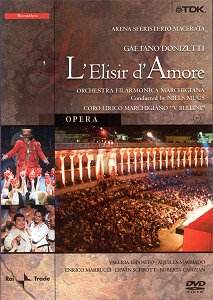This
breezy, exhilarating production proves that a modern, imaginative
opera concept does not necessarily have to be a homage to the
twisted eccentricities of self-promoting producers (I am thinking
for instance about the abomination that was the recent staging
of Korngold’s Die Tote Stadt).
Here
the vast arena of the Sferisterio in the Italian hill town of
Macerato (seen in the DVD box illustration reproduced above, and
celebrated in one of the two succinctly informative documentaries
that comprise DVD2 of this set) is used with great creative flair,
sympathetic to Donizetti’s original concept. Instead of curtains
the audience arrives to face a huge red box (see bottom right
hand corner of the same illustration). This contraption splits
in two, the halves retracting to left and right extremities of
the stage area. Revealed is the orchestra, backstage, bathed in
low-level, blue lighting so that the presence of the players is
discerned rather than ‘seen’. The performers: principals, chorus
and dancers are dressed in bright, neutral or very light peasant/military
costumes of the era of the opera - the beginning of the 19th
century. Minimal sets at the extremities echo contemporary engravings
and look like cardboard cut-outs, so does the quack doctor, Dulcamara’s
ox-pulled cart. Stage management is imaginative making full use
of the wide stage and even the conductor and orchestra are drawn
into the fun (but subtly, unobtrusively).
The
acting is first class and the young enthusiastic cast makes the
comedy spin along merrily. Valeria Esposito is a very natural
Adina whether she is taking shoes and stockings off to bathe her
feet in an imaginary stream at the edge of the stage or flirtingly
sweeping her hand across the face of a man in the orchestra. She
is teasingly capricious, flirty (in her mocking duet with Nemorino,
"Chiedi all’aura lusinghiera", but ultimately essentially
human and warm-hearted when she tells him that she has bought
back his enlistment papers rather than allow him to suffer in
the army just to earn the money for the elixir that he thinks
might aid her to win her love, "Prendi; per me sei libero".
Her frequent demanding coloratura passages are delivered with
confidence. Nemorino the simple, shy, ingenuous young farmer who
adores Adina is played with beautifully judged comic irony by
the chubby Aquiles Machado. His show-stopping aria "Una furtive
lagrima", (one of Donizetti’s simplest – shorn of any vocal
flourishes - but most affecting melodies) is delivered most affectingly.
Supporting
them are: the handsome swaggering Enrico Marrucci as the arrogant
Sergeant Belcore who lusts after Adina; Erwin Schrott as the flamboyant,
garishly-dressed quack doctor, Dulcamara whose potion (chianti)
gives the naïve Nemorino the (unnecessary) Dutch courage
to eventually win his love, and Roberta Canzion, an attractive
honey-toned lyric soprano who enchants as Adina’s friend, the
joyful young Giannetta.
Donizetti’s
melodic light-hearted score sparkles of course and the principals’
voices blend well in the frequent ensemble pieces. Just to mention
one such memorable number, Dulcamara’s comic "Io son ricco
e tu sei bella" (with Adina and choir). Erwin Schrott, a
robust-voiced bass-baritone, a really rascally Dulcamara, (who
had been urged by conductor, Niels Muss in the ‘Behind the Scenes’
documentary to sound more like an actor, less like a singer, "otherwise
its too easy for me to conduct") wears an unkempt grey wig
and thick spectacles and sings toothily as the old senator who
vainly tries to tempt a young girl with his wealth.
A
joyous, sparkling, imaginative production that will appeal to
admirers of Donizetti - and the additional ‘behind the scenes’
documentaries are above average too.
Ian
Lace
